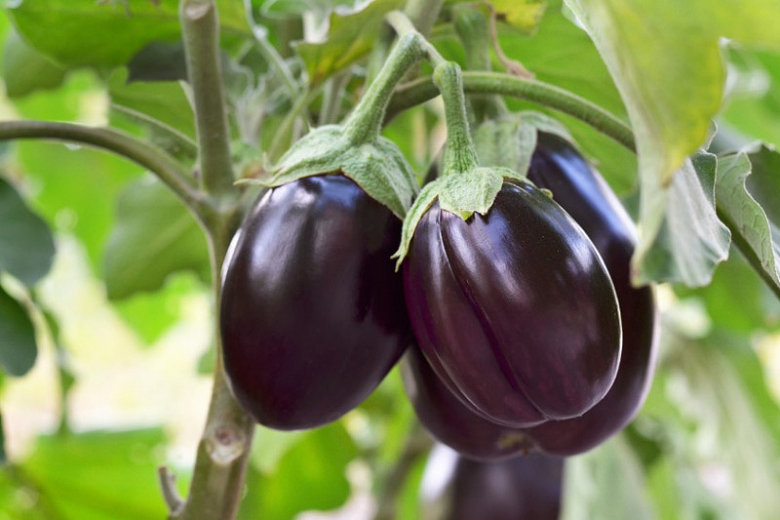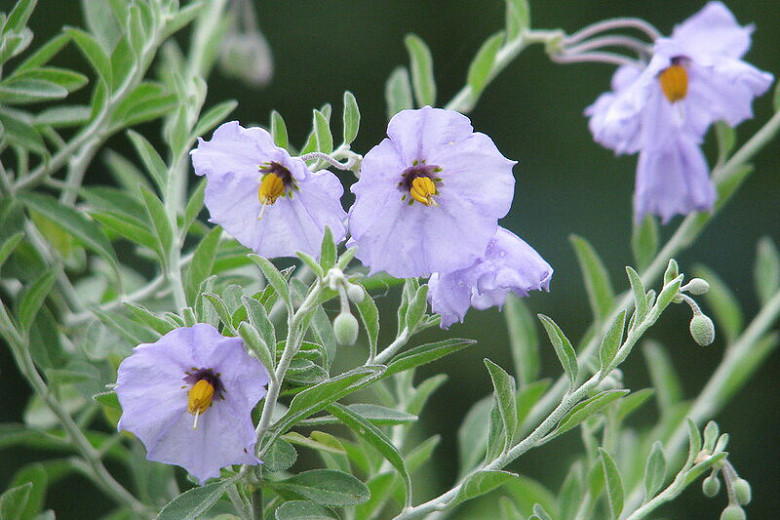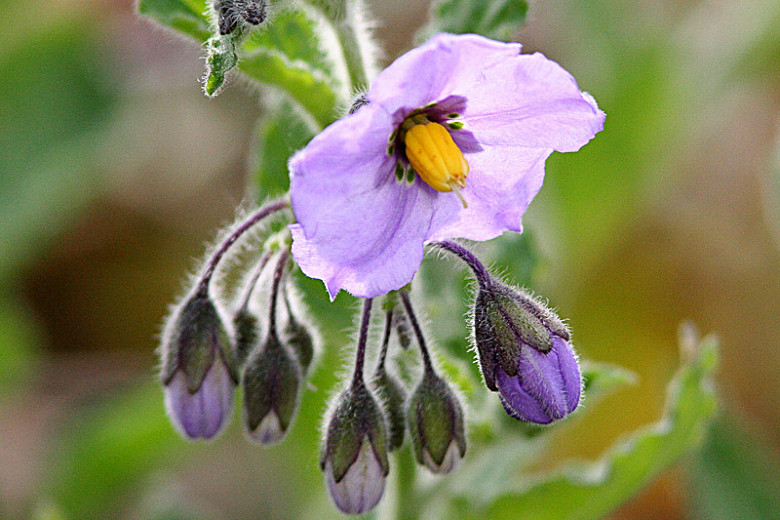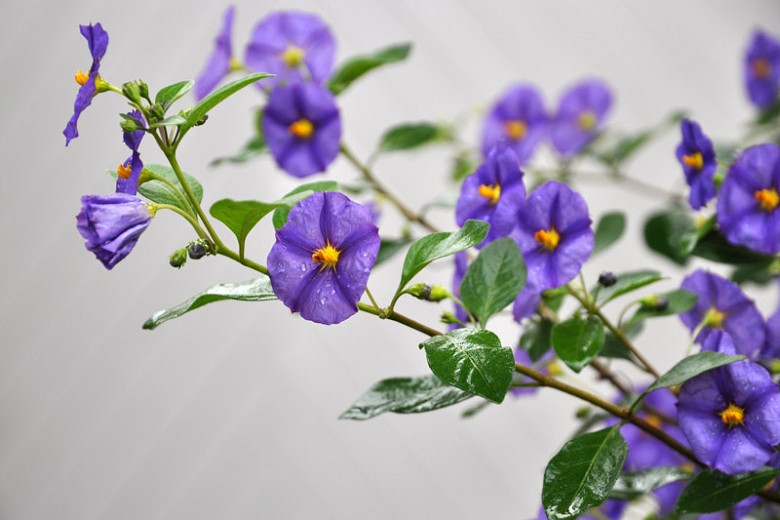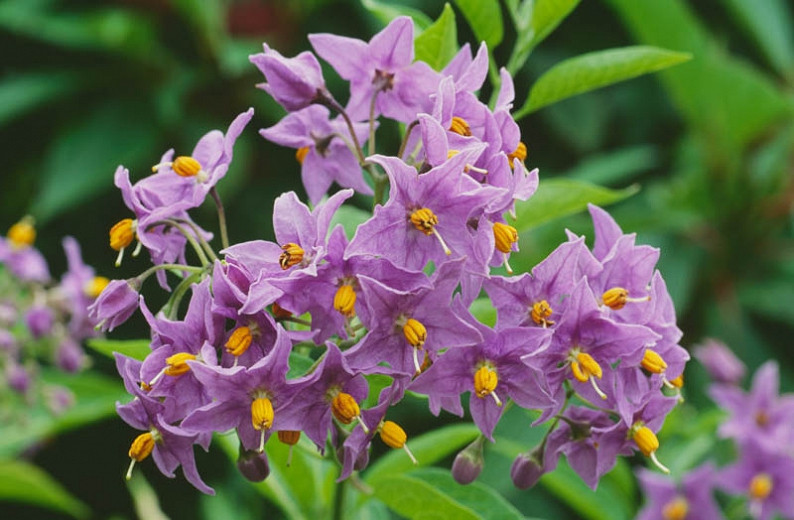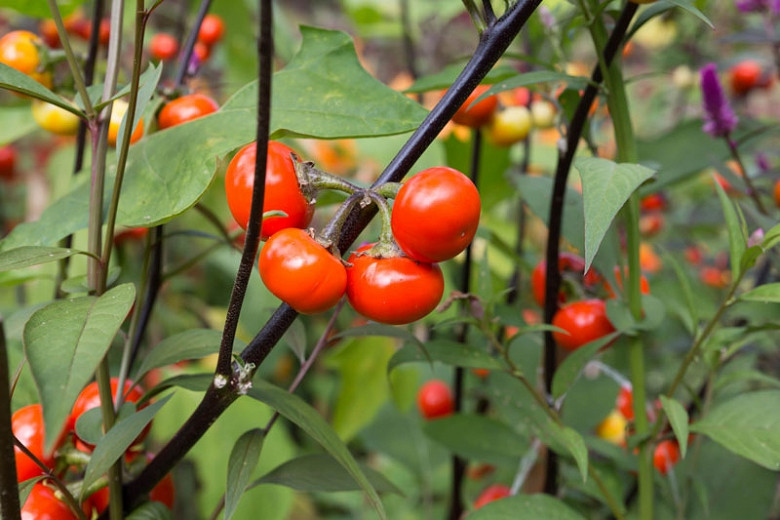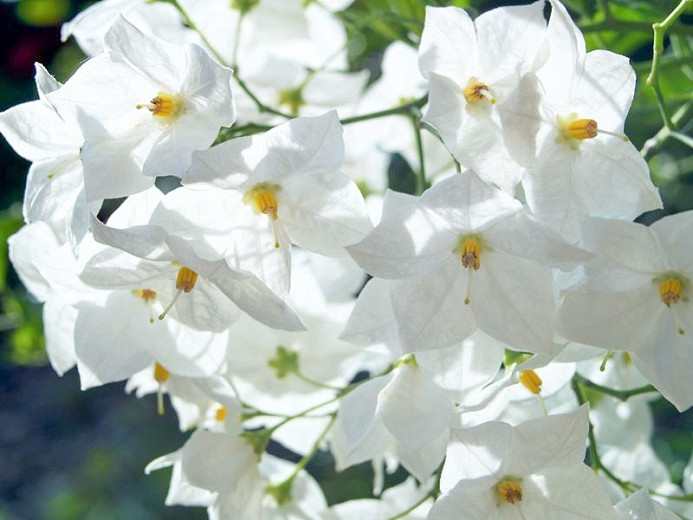Solanum melongena (Eggplant)
Both delicious and ornamental, Eggplants (Solanum melongena), also known as Aubergines, are tender perennials grown for their glossy, exotic-looking fruit. Easy to grow, they come in various sizes, shapes, and colors and are used in a wide range of dishes worldwide.
Both delicious and ornamental, Eggplants (Solanum melongena), also known as Aubergines and Brinjal, are tender perennials grown for their glossy, exotic-looking fruit. Easy to grow, Eggplants come in various sizes, shapes, and colors and are used in a wide range of dishes worldwide. In addition to bringing a unique texture and mild flavor to recipes, Eggplants bring several potential health benefits.
- Eggplants belong to the nightshade family (Solanaceae) and are a relative of peppers, potatoes, tomatoes, and tobacco.
- Although often considered a vegetable, Eggplants are botanically classified as a fruit, as they grow from a flowering plant and contain seeds.
- Eggplants originated in China and India and have been cultivated for thousands of years. The Spanish Moors introduced Eggplants into southern and Eastern Europe, where they became very popular.
- There are many Eggplant varieties that range in size and color – from glossy, purple, teardrop-shaped to oval, long and slender, or melon-shaped fruits with white, green, and even striped skin.
- Eggplants are versatile and are delicious when baked, grilled, fried, pickled, roasted, sautéed, or stuffed.
- Eggplants are cold-sensitive and require a long warm season for best results.
Main Types of Eggplant
Chinese Eggplant
- Chinese Eggplant is long and thin, 6-8 inches in length (15-20 cm), crooked or straight, with thin violet to bright purple skin. The flesh is white, semi-firm, and nearly seedless.
- Chinese Eggplant has a mild and sweet flavor. Because it has fewer seeds than Western Eggplant varieties, it is meatier and less bitter.
- Chinese Eggplant is popularly used in stir-fries and holds its shape when cooked. It can also be used for braising, sautéing, and grilling.
- Chinese Eggplant contains rich levels of anthocyanins, which gives the fruit its deep purple skin coloring but is also known for its antioxidant properties. It also contains some manganese, potassium, and vitamin B6.
- This Eggplant has been used in traditional Chinese medicine for thousands of years to help reduce toothaches, abscesses, wounds and sores, fever, and intestinal disorders.
- Chinese Eggplant is available year-round and widely available in Asia, Europe, Canada, and the United States.
- Also known as Oriental Charm and Pingtung Long.
Globe/American Eggplant
- American Eggplant is oval with a bulbous flat bottom that narrows towards the calyx and is about 10 inches long (25 cm) and 2-5 inches in diameter (5-12 cm).
- The skin is glossy, smooth, and black-purple. The cream-colored flesh is spongy-firm with many edible seeds.
- When cooked, American Eggplant is tender and mild with a slightly bitter taste.
- American Eggplant is best suited for grilling, pan frying, baking, broiling, sautéing, and roasting.
- American Eggplant is an excellent source of potassium, fiber, and anthocyanins, which offer antioxidant and anti-inflammatory properties.
- American Eggplant is available year-round, with a peak season in summer. This is the most common Eggplant variety in the United States, but it can also be found in Europe, Asia, and South America.
Graffiti Eggplant
- Graffiti Eggplant is noted for its unique shape, sweet flavor, and striped coloring.
- Graffiti Eggplant is small, teardrop shaped, 3-6 inches long (7-15 cm), with shiny and thin skin striped with purple and white. The flesh is creamy to pale white with small, edible seeds.
- Graffiti Eggplant is tender with a sweet and slightly fruity flavor when cooked.
- Graffiti Eggplant contains some vitamin C, iron, and fiber.
- Graffiti Eggplant is best suited for sautéing, grilling, stewing, roasting, pan frying, and baking. It can also be halved, stuffed, and baked with vegetables and grains.
- Graffiti Eggplant is available during the summer through early fall. It can be found in Europe, Asia, and the United States.
- Also known as Pandora Striped Rose, Purple Rain, Listada De Gandia, Shooting Stars, and the Fairytale Eggplant.
Indian Eggplant
- Indian Eggplant is small and egg-shaped, 2-3 inches (5-7 cm), with smooth, glossy skin ranging from deep purple, pure white, and lavender to green, depending upon variety.
- The creamy-white flesh is firm and crisp, with a few small edible seeds and a subtly sweet flavor.
- Indian Eggplant is an excellent source of fiber and contains some vitamin B6, vitamin K, and potassium. It also contains anthocyanins, which have antioxidant properties.
- Indian Eggplant is best suited for grilling, roasting, baking, and stir-frying. It can be sliced, grilled, used in pasta dishes, and is popularly used in curry-based dishes such as Bhurtha and Baingan Bharta.
- Eggplants have been a staple ingredient in Indian cuisine since ancient times, and India is the second largest producer of Eggplant in the world next to China.
- Indian Eggplant is available year-round, with a peak season in the spring, and can be found in the United States, Europe, and Asia.
- Also known as Baby Eggplant, Patio Eggplant, Ratna, and Brinjal.
Italian Eggplant
- Italian Eggplant resembles the Globe Eggplant in shape and color but is slightly smaller and sweeter. When cooked, IT IS tender and creamy with a rich flavor.
- Italian Eggplant is a good source of Vitamin C, Vitamin B6, fiber, and potassium. It also contains high levels of anthocyanins that are packed with antioxidant properties.
- Italian Eggplant is best suited for frying, baking, sautéing, grilling, and pickling. It can be sliced, fried, or grilled and used in eggplant parmigiana and pasta dishes.
- Eggplants have long been a classic ingredient in Italian cuisine and are one of the most popular summer vegetables. Popular Italian Eggplant varieties include Traviata, Naida, Rosa Bianca, and Nubia.
- Italian Eggplant is available year-round and can be found in Asia, the United States, Europe, and South America.
Japanese Eggplant
- Like the Chinese Eggplant, the Japanese Eggplant is elongated and slender, 8-10 inches long (20-25 cm), but it tends to have a darker purple color. The cream-colored flesh is nearly seedless with a dense, firm, and spongy texture.
- Japanese Eggplant has a sweet and mild flavor with subtly earthy undertones and develops a soft, tender, and creamy consistency when cooked.
- Japanese Eggplant is one of Japan's most popular ingredients for stir-fries and side dishes.
- Japanese Eggplant is a good source of vitamin C to strengthen the immune system. It also provides potassium, folate, manganese, B vitamins, phosphorus, copper, magnesium, and vitamin K. In addition, Japanese Eggplant contains nasunin, which contributes antioxidant-like properties to protect the cells against free radical damage.
- Japanese Eggplant is well suited for sautéing, pan-frying, deep-frying, grilling, and baking. It is popularly grilled to develop a smoky flavor, or grilled slices are tossed into salads for improved flavor.
- Eggplant production is the third most important vegetable cultivated in Japan.
- Japanese Eggplant is available year-round, with a peak season in the summer through fall. It can be found in Asia, Europe, the United States, Australia, and South America.
- Millionaire and Orient Express are the most common cultivars, but other varieties include Konasu, Kurume, Shoya Long, and Mangan.
Thai Eggplant
- Among the most miniature cultivated Eggplant varieties, the Thai Eggplant has the size of a cherry tomato. The smooth skin is glossy and ranges from dark green and light green to white.
- The flesh is pale green to white and contains many tiny, brown, edible seeds. Thai Eggplants are crunchy and mild with a slightly bitter taste.
- Thai Eggplant contains dietary fiber, potassium, manganese, and antioxidants.
- Unlike other Eggplants, Thai Eggplant can be used in raw preparations, such as salads and crudites. It is also well-suited for grilling, frying, baking, pureeing, stewing, stuffing, and pickling.
- Thai Eggplants are most popularly used in Thailand in Thai curry to add texture and flavor. The most common cultivars are Petch Siam, Tiger hybrid, Green Doll, and Kermit hybrid.
- Thai Eggplant is available year-round and can be found in Asia, Europe, and the United States.
White Eggplant
- There are two types of White Eggplants: an ornamental species and the commonly domesticated species. The ornamental Eggplant is used for adding snowy-white color to gardens. The domesticated Eggplant is used for culinary preparations.
- Slightly curved and oblong, 4-7 inches long (10-17 cm), their skin is smooth and bright white, while their cream-colored flesh is dense with many edible seeds.
- White Eggplants are creamy and mild with a light sweet flavor when cooked.
- White Eggplant is high in potassium and offers some B vitamins, magnesium, and copper.
- White Eggplant is best suited for sautéing, pan-frying, deep-frying, grilling, and baking. The skin is firmer than purple varieties and should be peeled before cooking.
- White Eggplant is available during the summer and can be found in Asia, Europe, and the United States.
- Main White Eggplant varieties are Casper, Easter Egg, Cloud Nine, Ghostbuster, White Beauty, Albino, and Tango.
Eggplant Health Benefits
- While Eggplants make a flavorful addition to various dishes, they can also provide some health benefits.
- Eggplants provide a good amount of fiber, vitamins (Folate, C, K), and minerals (manganese, potassium).
- Eggplants are also a great source of antioxidants, including nasunin, lutein, and zeaxanthin, that help protect the body from damage caused by harmful free radicals.
- Lutein appears to play a role in eye health and may help prevent age-related macular degeneration.
- Eggplants are rich in anthocyanins, a type of pigment with antioxidant properties responsible for their vibrant purple color.
- Eggplants are high in fiber and polyphenols, which may help reduce blood sugar levels.
- Eggplants are low in calories, making them an excellent addition to any weight loss diet. This low-calorie vegetable features in the Mediterranean diet.
- Eggplants contain several substances that show potential in fighting cancer cells.
Growing Eggplant
- Eggplants grow up to 2-4 ft. tall (60-120 cm) and 1-3 ft. wide (30-90 cm), depending on the variety.
- Eggplants perform best in organically rich, acidic to neutral (pH ranging from 5.8 to 6.5), moist, well-drained soils in full sun (at least 6-8 hours of direct sunlight per day) in a sheltered location.
- Eggplant is a heavy feeder and needs a high level of nitrogen and moderate levels of phosphorus and potassium.
- Before planting, add well-rotted organic matter or compost and work it into the soil. Alternatively, use a general fertilizer such as 5-10-5 throughout the planting bed about a week before planting.
- Keep the soil evenly moist but not soggy.
- Depending on the variety, Eggplants take 65 to 80 days to harvest after transplanting and 100 to 120 days after sowing.
- Eggplants need warm conditions and will not thrive during a cool season. They are sensitive to frost and grow best between 70-85°F (21-29°C).
- Eggplants perform poorly when temperatures rise above 95°F (35°C) or fall below 65°F (18°C). Eggplant roots are subject to cold damage, and plants seldom recover from cold snaps.
- Eggplants are great for containers, raised beds, and greenhouses and can be very ornamental in borders.
- Eggplants can be purchased as 6-8-week-old transplants (easiest) or started from seed indoors 8-10 weeks before the last spring frost date. Purchase sturdy, pest- and disease-free plants.
- Sow seeds ¼ in. deep (0.5 cm) in flats or peat pots.
- Eggplant seeds germinate best between 80-90°F (26-32°C). Grow seedlings at (21°C) and keep them indoors until average daily temperatures have reached 65-70°F (18-21°C).
- To help speed soil warming, cover the soil with clear plastic at least 2 weeks before you want to plant.
- Plant seedlings 24-30 inches apart (60-75 cm) in rows 3 feet apart (90 cm). Water thoroughly.
- Mulch to retain moisture, keep the soil warm, and control weeds.
- Use a row cover to boost the seedlings and keep them warm and sheltered – if you live in a cold area.
- Staking your Eggplant plants will keep the stems from breaking or drooping from the weight of the fruits and keep the fruits from touching the ground.
- Apply a balanced fertilizer every 2 weeks once the first fruit starts to form.
- For bigger fruits, pinch out terminal growth and flowers to allow up to 5 or 6 fruits to mature.
- Eggplant tastes best when harvested young. Harvest Eggplants when they reach adult size and their skin has become shiny and smooth. Regular picking will encourage further production.
- Rotate crops: Do not plant Eggplants where tomatoes, potatoes, or peppers have been planted within the past 3 to 5 years.
- Eggplant is susceptible to a few pests. Keep an eye out for aphids, Colorado potato beetle, flea beetle, slugs, snails, glasshouse whitefly, and glasshouse red spider mite.
- Eggplant is susceptible to diseases, including tobacco mosaic viruses.
Best Companion Plants for Eggplants
Requirements
| Hardiness | 9 – 12 |
|---|---|
| Climate Zones | 1, 1A, 1B, 2, 2A, 2B, 3, 3A, 3B, 4, 5, 6, 7, 8, 9, 10, 11, 12, 13, 14, 15, 16, 17, 18, 19, 20, 21, 22, 23, 24, H1, H2 |
| Plant Type | Fruit |
| Plant Family | Solanum |
| Exposure | Full Sun |
| Season of Interest | Summer (Mid,Late)Fall |
| Height | 2' – 4' (60cm – 120cm) |
| Spread | 1' – 3' (30cm – 90cm) |
| Water Needs | Average |
| Maintenance | Average |
| Soil Type | Chalk, Clay, Loam, Sand |
| Soil pH | Acid, Alkaline, Neutral |
| Soil Drainage | Moist but Well-Drained |
| Attracts | Bees |
| Garden Uses | Beds and Borders, Patio and Containers |
